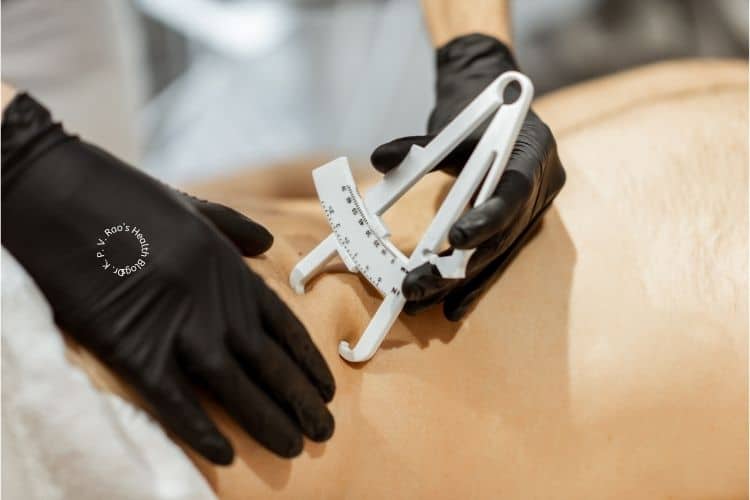WHAT IS BODY FAT?
Body fat refers to the amount of fat stored in your body. It serves as an essential energy reserve and insulation, but excessive body fat can lead to health issues.
Methods to measure body fat
To measure body fat, several methods are commonly used, including skinfold thickness measurements, bioelectrical impedance analysis (BIA), dual-energy X-ray absorptiometry (DXA), and air displacement plethysmography (ADP).
How is measuring body fat useful?
These methods provide insights into your body composition and can help assess your overall health and fitness levels.
Regularly monitoring body fat can be useful for tracking progress during weight loss or fitness programs, including monitoring health issues like hypertension, hypothyroidism, diabetes, etc.
Last time I wrote on obesity was on 3 rd December 2018. In that article, I had discussed what are the consequences of obesity.
In this article, we’ll learn how to measure body fat that causes obesity, by various methods.
The two main types of body fat
As you already know there are 2 main types of fat–the subcutaneous[that below the skin] and visceral[that surrounding our organs].
Can we measure them separately?
Yes we can.
For us, the important part is the VISCERAL fat,which is the root cause of many medical problems and the one we want to reduce at the earliest. We can measure total body fats without use of machines.
How do we measure body fat without machines?
To measure total body fat without using machines, you can use the skinfold caliper method.

This involves measuring the thickness of skinfolds at specific locations on the body using calipers. These measurements are then used to estimate body fat percentage.
After taking measurements with skinfold calipers, you can calculate the total body fat using this calculator-
Visceral Fat and the bad effects of excessive Visceral Fat
Visceral fat is harmful and can lead to various health issues. Excessive visceral fat is associated with
- an increased risk of cardiovascular diseases,
- type 2 diabetes,
- high blood pressure, and
- certain cancers.
It can also adversely affect insulin sensitivity and hormone balance. To maintain a healthy weight and reduce visceral fat, focus on regular exercise, a balanced diet, and stress management.
How do we measure Visceral fat
There are many ways to do so—one of which is waist-to-hip ratio which we have already discussed.
Another simple way to measure visceral fat is to take the circumference of your tummy at the highest point while standing and again while lying down—the difference is the measure of your visceral fat.
Alternative ways to measure body fat
Then we have other sophisticated methods which can be carried out at a slimming center or at doctor`s clinic offering obesity control services.This is called bio-electrical impedance where the total body fat is measured and the amount of visceral fat is calculated.
You can measure total body fat and calculate visceral fat through the bio-electrical impedance method. This can be done at a slimming center or at a doctor’s clinic specializing in obesity control services. For more information, you can refer to this link: Bio-electrical Impedance Analysis (BIA)
What is Bioelectrical Impedance Analysis and its use in measuring body fats?
Bioelectrical Impedance Analysis (BIA) is a method used to measure body fat percentage. It involves passing a low-level electrical current through the body and analyzing the resistance encountered. BIA is based on the principle that adipose tissue (fat) conducts electricity differently than lean body mass (muscle and organs).
BIA is widely used due to its non-invasive nature and ease of use. It provides a quick and convenient way to estimate body fat percentage and monitor changes over time. BIA devices typically consist of electrodes placed on the hands and feet, or sometimes on specific body segments.
Limitations of BIA
However, it’s important to note that BIA has some limitations. Factors such as hydration levels, temperature, and exercise can affect the accuracy of the results. Additionally, BIA may not be as accurate as more advanced methods like dual-energy X-ray absorptiometry (DXA) or hydrostatic weighing.
In conclusion, BIA is a commonly used method for estimating body fat percentage. While it provides a convenient and non-invasive option, it may not be as accurate as other techniques. It is recommended to consult with a healthcare professional for a comprehensive assessment of body composition.
Suggested reading-
Conclusion
In this article, we discussed about body fats and two methods to measure it. Having said this, we now learn methods to reduce/eliminate this visceral fat if it is in excess.This we will discuss in my future blog/s.
Final Words
If you have found this article useful, do promote my blogs by sharing it with your friends and family using the social media channels below.
Alternately, you can Click to Tweet here-
How to measure Body Fat Share on X

